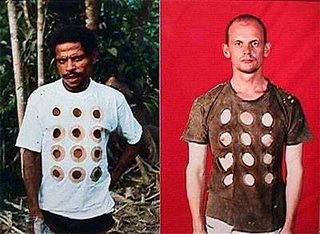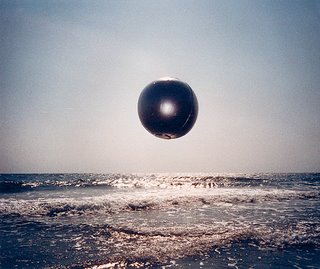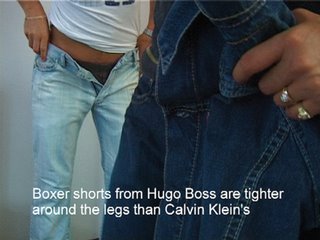
Just look around, there´s some gold to find here.


Abts' win on Monday night has been widely interpreted as the Turner Prize correcting itself. As well as being the first woman and the first painter to win the prize in almost a decade, after years of artists with personas as feverishly worked upon as their art, here was someone about whom we knew practically nothing: 38 years old, from Kiel in Germany but resident in London for the past 12 years, and (rumour had it) the former girlfriend of Chris Ofili - that's pretty much it. Efforts to extract more would, as you will see, be a painful experience. We meet around the corner from Abts' studio in Clerkenwell, which she has occupied since she first came to London on a grant. She had been living in Berlin, doing a mixed media art course in which she had concentrated mainly on film - "structuralist films" - while doing her own painting on the side. The Berlin art scene at that time was a little "sleepy", she says, whereas London was just starting to swing with the YBA movement. Abts moved to the city not because she wanted to join in - she's not really a joining-in kind of gal - but rather to enjoy, at a tangent, the energy and interest in art that it generated. "It's quite nice to have that bit of distance, to have my own personal space to develop my work," she says.
For a couple of years she got by on the arts grant, and then was forced to find work. "I had strange jobs, like telephone marketing type jobs for German companies." It was only four years ago that she was able to live solely off her art, and it was a huge relief finally to give up the day jobs.
Abts has never had formal training in fine art and hasn't taken a painting lesson in her life. The town she grew up in was "not very exciting" - she summarises its main features as "sea" and "nice landscape" - but the idea that news of her win might appear in the local paper makes her smile broadly. Abts' parents still live in Kiel and told her proudly that she had made the national news in Germany on Monday night. They have always encouraged her, she says, and her upbringing was "very free." I ask if her parents do anything artistic.
"No."
What do they do?
"Do I have to say?"
Yes.
"My mum is a teacher in a primary school and my dad is a gynaecologist." She smiles sheepishly.
Is it true that you used to go out with Chris Ofili?
The smile falters. "I won't talk about that."
I tell her that I hope she did.
"Why?"
Because then you could be characterised as a former golden couple, the Posh and Becks of the art world. (Ofili won the Turner Prize in 1998.)
Abts looks horrified. "No comment! I don't think these private things should be part of art, in a way." Without naming names, she goes off on a riff about self-cannibalising artists who make their careers by rummaging about in their own detritus. "It [the Turner] used to be such a personality-based prize and I think that's not appropriate, necessarily, for art. I think it should be about the art and not the personality. These private things should not be mentioned."
OK. Are you married?
"No." She cracks up laughing.
Abts used to work on canvasses of all sizes, but somewhere along the line she started feeling most comfortable with a single size, a modest 19in by 15in, and has stuck with it ever since. She paints sitting down, and the canvas fits the arc of her arm. It's an agonisingly slow process, she says, and she will sometimes put a canvas away for a couple of years before returning to complete it. "They're such slow paintings to make that I think they might also be slow to look at ... that people might not really notice what's going on."
This isn't false modesty. Abts was surprised by the warm reaction of the critics to her work in the run-up to the Turner Prize. (In October, the Guardian's critic Adrian Searle wrote: "Abts' quiet and disturbing paintings seem utterly right and unexpected. They ought to win.") She has always painted for herself, on the side, and the fact that it has ended in glory is something she finds quite amazing. But her self-containment that might also be construed as arrogance. She won't name any influences, or works of art that first inspired her as a child, or her favourite past winner of the Turner Prize. She's not even sure she could name them.
I ask what she thinks of her co-nominee, Phil Collins, whose conceptual work based on the perils of reality TV was about as far from Abts' paintings as you could get. "It seemed to me," she says, "that for what he was doing, he was doing it very well." This sounds pointed, but perhaps that's just wishful thinking.
It is said that winning the Turner Prize doubles the value of an artist's work overnight. No, says Abts. "Maybe some galleries and artists would do that, but not the people I work with." She considers art a calling, not a career, and she didn't go into it to make money - well, who does? Actually, she says, she thinks young artists today have a rather warped attitude in this regard. "It seems that these young artists think of it as a career choice, to do art; they think that it will pay off and they'll make money." She looks doubtfully out the window. "Maybe they will."
Why does she think so few women have won the Turner Prize? "I don't know, because to me it feels that in the last few years a lot of female artists have been very dominant. In a way maybe [the prize] hasn't represented what's happened. I'm sure they were thinking that it was time a woman won it. I'm sure there are those kind of strategic decisions [going on]."
Abts' paintings are like palimpsests, multi-layered, and it gives one little jolts of pleasure to look at them, although it's impossible to say why. They require no external stimuli, no subject matter and no obvious end point. Starting a new painting is, says Abts, "the easiest part for me, because I have so many visual ideas. Colours, or starting to make shapes or thinking about where things go, that's easy. Then just trying to make it more concrete and trying to make some kind of meaning."
What is the meaning? Abts doesn't mind art that requires an explanation alongside it, but equally, she doesn't think one needs to explain - or even know - why something is good. There has been much discussion about how she can tell when one of her paintings is finished. Instinct, she says. "A question of balancing it all out or making it darker or ..." Anyway, she just knows. She very rarely abandons a painting, but when she does it's because she has painted over the canvas too many times and it has become bumpy.
"I can't really ever say what it will look like or how it will finish or what will make it work. It's a different idea or moment for each painting. It's not really... I try so much with the composition and colour, and get closer and closer, and then there's always a moment where there's a surprise, when I try something and ... everything is in place."
Isn't it scary, not being able to formalise what she is doing, has done, or is going to do - why any of it works or doesn't work? "It is scary!" she says. "Sometimes I think, God, I don't know if I will ever finish another painting because I don't know how to do it. But then it keeps happening ..."
She frowns and has another crack at it. "What is an interesting idea for me is something being ... an image and at the same time an object." We talk about Jasper Johns' Flag as an example of this: a painting, a flag, and also a representation of a flag. "When I finish [a piece of art] it becomes congruent with itself."
There is a confounded silence. "I don't know what that means," she says, and, with a lack of pretension we may not see again in a Turner Prize winner, laughs uproariousy.

Rauschenberg went his own way. When abstract expressionism was at its height, the young artist responded by painting a series of uninflected white paintings. Soon he was painting monochromes, then red paintings. In 1953, the artist spent hours at work with an eraser, rubbing out a drawing by Willem de Kooning, leaving only the ghostliest trace of an image on the sheet of empty paper. At the time, these gestures were regarded as baffling or inconsequential, if they were regarded at all. Yet, even as false starts to a career that has spanned more than half a century, they would have been enough to secure Rauschenberg's place.
The same year he erased De Kooning's drawing, Rauschenberg began a way of working that came to be seen as a bridge between abstract expressionism and pop art, between postwar heroics and 1960s cool. The same has been said of Jasper Johns' work. Rauschenberg and Johns were partners during the 50s, trading ideas and colluding in one another's career strategies. Initially, they made their living doing shop window displays for Tiffany's and Bonwit Teller. Both, arguably, produced their best work together, Johns' reserve and Rauschenberg's impetuousness providing a foil for the other.
What Rauschenberg came to call his Combine paintings are the core of his art, and the subject of a major travelling exhibition, currently at the Pompidou Centre in Paris. In his preface to the show, Paul Schimmel of the Los Angeles Museum of Contemporary Art calls the Combine paintings "some of the most influential, poetic and revolutionary works in the history of American art". One might quibble: other works and artists might have as much of a claim, and 50 or so years on, Rauschenberg's Combines may not appear quite so revolutionary and radical as the works he made immediately prior to them. But these ramshackle hybrids between painting and sculpture, stage prop and three-dimensional scrap-book assemblage, have neither given up all their secrets, nor have they quite settled down as tame museum artefacts. However much conservators worry over them, and academics examine their surfaces and hidden corners - like car mechanics, in search of secret subtexts and hidden codes - they have almost too many possible readings. Their richness is itself perhaps an allegory of the excess of modern life, the postwar consumer boom.
Rauschenberg has always resisted the idea that the Combines have any secrets or narrative, other than the chance encounter of disparate elements. If they have any meaning, it is in their profligacy, their inclusiveness, their physical attempt to wrestle with high culture and low - and with no culture at all. The different elements of the Combines have been described as having no more relation than the different stories that vie for attention on a newspaper page, or the objects that find themselves on the same tabletop.
But serendipity and opportunism are never entirely random. The Combines are full of jokes, camp replays and caricatures of just about every earnest New York School cliche, as well as startling and unforgettable juxtapositions. The poor stuffed Angora goat Rauschenberg somehow acquired migrated from a wall-mounted painting to a panel on the floor, with a car tyre round its midriff and its head slathered in a fright-mask of glutinous oil paint. It was given the unlikely name of Monogram. Both goat and artist would be justified in asking how they got here. Maybe all art is to a degree self-portraiture, against which self-parody is no defence.
In 1957 Rauschenberg painted the same painting twice (Factum I and Factum II), with the same brush-strokes and drips, the same collaged calenders and photos. The doubling of the painting - one of which currently lives in the Museum of Contemporary Art in Los Angeles, the other in New York's Moma - is a great comment on the "authenticity" and supposed uniqueness (as an event as much as an object) of paintings. These paintings are themselves filled with doubles: two trees, two photos of Roosevelt, two photos of a fire in a launderette.
The Combines are bursting with ideas, as much as with physical and painted material. A brick dangles on a cord, in front of a found painting of a tropical beach - as if one could smash the view, like a brick through a painted window. This almost Magrittean moment is followed, in the same work, by a softball hanging above a fork, as though it had just been tossed and is about to be caught again. Suspended time and irreversible decay are recurrent themes. A stuffed pheasant stalks a ledge atop another canvas, and a veritable menagerie of stuffed roosters, chickens, an eagle and a heron preen and wilt in other works. Icarus and Ganymede, the randy rooster and America's national bird, all have their place. Symbolism is unavoidable, but Rauschenberg never felt much like taking responsibility for any of it.
Litter from the street is swept into the studio and through the work. Newspaper clippings trodden into the painted mulch, remnants of fabric hanging like banners and poor curtains, reproduction Old Masters, private letters and photographs, Coke bottles, radios, electric fans - waste of all kinds snags our attention as we pass.
The current state of the Combine paintings is itself one of suspended decay, lending the work an almost overwhelming air of melancholy. With time, the paintings tend towards muck: the tatty and yellowing papers, the squalid empty planes stained with dribbles and faint colour. Once, all this looked new and hip.
Rauschenberg's awkward but much-quoted remark - "Painting relates to both art and life. Neither can be made. (I try to act in the gap between the two)" - has since been used to justify all kinds of activities that might not look like art-making at all. What is important about Rauschenberg's statement is not so much the bit about the gap betweeen art and life, so much as the observation that neither can be made. In other words, stuff happens. And stuff happens everywhere in these paintings. A rooster crows, a nude poses on a log, a runner pounds the track, paint drips, lights flicker, a radio plays. Rauschenberg's son writes to his absent father, and the artist pastes the letter to a Combine painting, rather than keeping it in a drawer. A sister wins the local beauty contest; a departed lover leaves his scribbled breath on the pillow. It all ends up in the work.
The Combines have been likened to combine harvesters - threshing their way through the world, and through Rauschenberg's life. In a short BBC film made on the occasion of Rauschenberg's exhibition of Combines at London's Whitechapel Art Gallery in 1964, the artist looks terrified and camera shy as he is interviewed. Rauschenberg deflects almost all efforts to make him talk about his paintings. There is a clip of the artist at work, smearing an area of paintwork with a rag. Although the result looks purposeful and vigorous, Rauschenberg appears indifferent as he tracks the wet sludge about the surface. He knew precisely what he was doing, if not exactly what it meant - or if he did, he wasn't saying. Recently, he said: "I remember those works as if I had made them yesterday, and I don't remember what I made yesterday."
With time, the meanings gather. Rauschenberg's Combines occupy the same floor of the Pompidou as a breathtaking retrospective of Yves Klein, three years younger than Rauschenberg, and who died in 1962. For all their openness and inclusiveness, Rauschenberg's Combines turned into a style like any other. By the time Klein died, the Combines were beginning to look exhausted. Klein's work, on the other hand, which was often accused of being kitsch, vulgar and ephemeral, looks as alive now as ever. But it is oddly static and sterile; it looks as though Klein didn't know what to do next either. And while Rauschenberg's Combines point in all sorts of directions, into the future as well as the past, Klein's art is a frozen, perpetually stalled moment.
· Robert Rauschenberg: Combines, is at the Centre Pompidou, Paris (33) (0)1 44 78 12 33, until January 15. Centrepompidou.fr
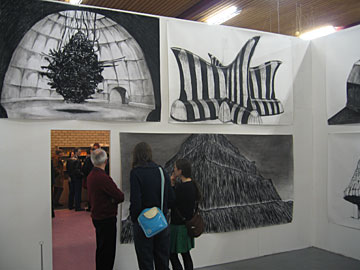

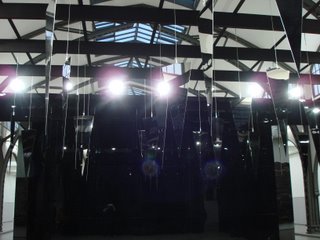









It has a sense of anxiety and self-loathing; amid this are angry protests, displays of mock insouciance, and tragicomic buffoonery. Ryan Tracartin's sculptures made me laugh out loud. At 25, he is as much a film-maker as a sculptor, and his sculptures look like props. Until Hurricane Katrina, he was based in New Orleans. World Wall is a kind of childish grotto, with bits of bodies poking out of the walls, a huge, cave-like open mouth where a living room once stood, mad bulging eyes, a house whose roof is painted over with waves. An unnaturally skinny naked mother stalks the floor, head aloof. The unattractive but game Vicky Veterinarian has a cat burrowing in her shirt. Mango Lady's skin is made from mango peel. The characters are all in search of a plot, but there isn't one.
The painted and sculpted human beings throughout USA Today seem variously dumb, stupid, aggressive, abject, forlorn, ridiculous, damaged, sick, in distress, screwed up. This can be no coincidence. Or perhaps Saatchi has a taste for this sort of thing, this dismal view of the world. Almost everything else here shouts, screams, lacerates itself in self-loathing, hectors, assaults, appals, insults.
In Fuck the Police, Dash Snow presents 45 framed press clippings: Cops Busted in Sex Abuse, Cops Who Killed For Mafia, Cop in Coke Ring. The catalogue tells us Snow "started taking photos when he was a yobbish teenager", and that the headlines are all "splattered with jism". Well, that changes everything.
Perhaps the most telling sculpture is an anonymous figure, either cowering or in prayer. The body is a black bin-liner. Brown clay hands reach forward, palms flat on the floor. Behind the figure is a trail of crumbled clay. Huma Bhabha's sculpture has an odd vulnerability, however curtailed an image of a human it presents.
After 9/11, after Hurricane Katrina, after Iraq, Afghanistan, Guantánamo, what should one expect from American culture, apart from rage and crawl-into- a-hole-in-the-ground-and-die abjection?
Perhaps that is what LA-based Jon Pylypchuk intends: his miserable little figures, touchingly dressed in remnants of fabric, stagger about on the floor, gather helplessly around the wounded, vomit in shock on the ground and upon each other. It is a horrible roundelay. All this goes on at ankle height. "Hopefully, I will live through this with a little bit of dignity," the title reads. Dignity is in short supply here. How about 222 plaster, wax and charcoal heads, each damaged in some way, each set inside a grubby little vitrine, in Beijing-born Terence Koh's Crackhead? Koh can't be accused of subtlety, any more than Banks Violette and her sculptural tableaux.
Violette's work is sculpture that wishes it was as edgy as a death-cult heavy metal band, but is about as dangerous as Spinal Tap. His casts of electric guitars, mock amplifiers and drifts of salt and sugar faking cocaine have schlock value, but little else.
In Barnaby Furnas's paintings, men in suits are being turned to mincemeat in a shoot-out on Hamburger Hill, and a flood of urethane red, like a bloody response to the poured and stained 1960s colour field paintings of Morris Louis, roars through a blue sky in another mammoth canvas. I can just see this sanguinous deluge displayed with pride in some American corporate lobby somewhere. That is one of the problems with art that attempts to make statements: it gets assimilated.
Paint becomes snot in a painted sneeze by Dana Schutz; she paints feelings as though they were regurgitated food. In one canvas, a head eats its own face, as well it might.
Schutz's paintings are at least funny and intelligently made. There are some silly paintings in this exhibition: a self-consciously badly painted decapitated horse with a huge penis, bluntly crass paintings of bits of bodies, Gerald Davis's deeply unpleasant paintings of adolescent sexuality.
Davis paints pubescent Monica giving head, and an x-ray view of teen Linsey's full colon, accompanied by a painted diary entry about her exquisite bathroom experience in the shopping mall. Where do we go with images like these? Am I meant to admire their more abstract qualities, or feel all smug at their sophisticated ironies?
USA Today is neither as good as I wanted it to be, nor as bad. When I say bad, I mean angry, lacerating, bitter, disillusioned, pained and powerful. In New York's Whitney Biennial, Richard Serra showed a rough little drawing of a now familiar image: a figure hooded in black, standing with outstretched arms on a box, waiting, so he thinks, to be electrocuted. "STOP BUSH," Serra scrawled on the drawing.
It may not be great art, but it doesn't need to be. That's the problem. I want an art more powerful - not just loud, not just blunt. Most of art's audience already know what they think about the state of America and the war on terror. The job of artists, novelists, film-makers, musicians and playwrights demands that they go further than stating the obvious. USA Today is an expression, more than anything, of impotence.
· USA Today is at the Royal Academy of Arts, London W1, from tomorrow until November 4. Details 020-7300 8000.

It is, in short, always something of a soap opera, which is why it is particularly appropriate that, as part of his section of the exhibition at Tate Britain in London shortlisted artist Phil Collins has set up a fully operational TV production office, called Shady Lane Productions.
Collins is asking members of the public to contact the office if they have had a damaging experience as a result of appearing on a reality or makeover show.
He will then invite participants to tell their side of the story, unedited, for a resulting programme called The Return of the Real, a sort of "what-happened-next". Collins's own reaction to his shortlisting was: "I thought about it for a week. It felt like that moment in [the film] Carrie when she has a bucket of blood thrown over her and is made a fool of on a grand scale."
Lizzie Carey-Thomas, one of the Tate curators who has put together this year's exhibition, said that this year's artists "cover all bases". Apart from film-maker Collins, the other shortlisted contenders are a painter, a sculptor and an installation artist. It is the second year running a painter has made the shortlist. Tomma Abts's non-representational oils, unvaryingly 38cm by 48cm, are made, as Ms Carey-Thomas put it, "with no source material, no sketches and no preconceived idea of how they will end up". Working with a combination of utter precision and total intuition she applies paint until, gradually, a shape emerges, though the work may go through wildly differing stages before the final form is found. Ms Abts says that the painting is complete when "it suddenly has an atmosphere and makes you feel something". The work is then given a title using a dictionary of first names from a particular region of Germany.
The other contenders are Rebecca Warren, whose clay sculptures reference figures such as Rodin and Dégas and whose lumpy, bumpy, hyper-feminine forms gently debunk her artistic forebears; and Mark Titchner, whose installations draw on defunct belief systems and outmoded science to "question the codes by which we live today", according to Tate curator Katharine Stout.
The unveiling of the exhibition was, however, overshadowed by comments made at the weekend by one of this year's jurors. Journalist Lynn Barber, writing in the Observer and breaking the convention that jurors remain silent at least until the prize is awarded, quoted an extract from her diary saying that she felt "demoralised, disillusioned, and full of dark fears that I have been stitched up - that actually the art world has already decided who will win the 2006 Turner prize and that I am brought in purely as a fig leaf". She also said the experience of being a Turner prize judge had "seriously dampened" her enthusiasm for contemporary art and that she had tried to "warn off" a colleague, writer Miranda Sawyer, from accepting an invitation to become a juror for the 2007 prize.
Stephen Deuchar, director of Tate Britain, said of Barber's article: "I think it was tongue in cheek. This was a very personal account of how she found the process and very good-humoured. I'm very relaxed about it - she's very engaging and slightly self-deprecating and honest."
This year's prize is awarded in a ceremony at Tate Britain on December 3. The winner will receive £25,000 and the runners-up £5,000 each. This year's jurors, apart from Ms Barber, are Margot Heller, director of the South London Gallery; Matthew Higgs, director of White Columns gallery, New York; and Andrew Renton, director of the curating course at Goldsmiths College, University of London. Chairing the jury is Tate director Sir Nicholas Serota.
According to Sir Nicholas, the prize "cannot possibly cover the full range of new developments, nor survey all that is important in contemporary art in Britain. Nor is the prize intended either as a long-service medal, or as a forcing ground for new talent. It answers the simple questions, what were the exhibitions, which were the works of art and who were the artists whose work had the strongest and most enduring impact this year on this group of individuals, the jury?" To be eligible artists must be under 50 and living or working in Britain. Previous winners since the prize's inauguration in 1984 have included Martin Creed (2001), Chris Ofili (1998), and Damien Hirst (1995).
THE TRUTH OF THE MATTER | ||
| ||
LUC TUYMANS, | ||
| ||
With Tuymans we jump from endgame to postgame wrap-up, a commentary on the | ||
| ||
This is why we shouldn't expect or require an individual masterpiece from Tuymans. |
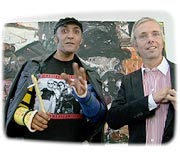


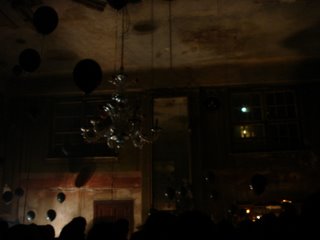



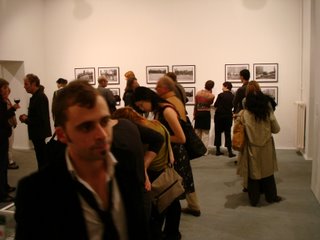









08/07/2006 t/m 08/10/2006
In his first museum solo at the GEM, Hague artist Vittorio Roerade (b. The Hague, 1962) presents work produced over the last six years. In his paintings, Roerade uses unorthodox techniques and materials to fairytale figurative effect. He combines beeswax with photo-collages, pours on epoxy resin, perforates his works and decorates his pictures with hair and embroidery. The main themes of his strange and moving matter paintings are the fragility of human life and the interconnection of everything on earth.